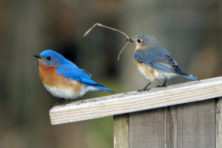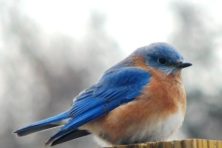Door to Nature: Helping Eastern Bluebirds
- Share
- Tweet
- Pin
- Share

The warmer-than-average weather we’ve been having reminds me of the spring of 2012. Temperatures were normal during the first week of March, but by March 11, they reached a high of 65 degrees. During the next nine days, temperatures stayed in the 60s, and by March 20, hepatica and spring beauty flowers were in bloom.
We noted on March 20 that the first chipmunk was out for the season. This year, one was out on a warm day in early February, and again on Feb. 25.
On March 21, 2012, the high temperature reached 81 degrees. The rest of the month was close to normal. By the end of the first week of April 2012, morning lows were under 32 degrees. Freezing temperatures at dawn continued on and off until April 27.
Some of you living here at the time may remember that 2012 was the year the tart cherry crop was a failure; blossom set was early and got hit with killing frost.
Eastern bluebirds usually return by mid to late March. In 2012, they came early and began nesting, encouraged by the warm weather and the crop of insects that was present.
When the freezing mornings began, we purchased live mealworms from Grubco, a company in Fairfield, Ohio. We bought some small plastic condiment cups at Walmart and Roy screwed them to the tops of the nest boxes. Each morning, we drove along our bluebird trail route and I placed live mealworms in the cups.The adult bluebirds ate them eagerly and fed them to their chicks once the young hatched.
If the adults don’t get enough food to eat, they cannot produce youngsters. We were so afraid that we would lose a number of adult bluebirds that year, but they all survived and 2012 was a banner year for bluebird production.
Mealworms come in various sizes, and keeping them alive and healthy for the birds requires special care. Grubco handles a variety of foods for different pets and offers good instructions on how to care for the food. The company will not ship mealworms if the weather is too cold or too hot.
If anyone wishes to help bluebirds by placing nest boxes out for them, there are some important things to consider. First, the box should be in the proper habitat. Bluebirds get all their food on the ground rather than in the air, so they need short grass or mowed roadsides to find the insects that are crucial to their diet. One favorable nest box site we found was along the roadside, under power lines and just beyond where the county mowers reach.
The birds like to sit on wires or trees near the road to look for insects. They need lots of space, so do not put boxes close together.
The cool winds blowing off Lake Michigan in the county mean that you’ll find bluebirds away from the lakeshore, perhaps a mile inland. It’s a good idea to set the box so that it can warm up in the sun for the first half of the day. If you want to put a nest box closer to the lake, you may get a tree swallow, a black-capped chickadee or house wrens, all of which are cavity nesters.
Try to think like a bluebird. Once the youngsters are ready to leave the nest, they must fly to a nearby tree where they can exercise and strengthen their wings. The trees can be anywhere from 20 to 100 feet away. If they land on the ground, they will probably perish because their wings are not strong enough to fly up to a tree branch.
You may see nest boxes with openings facing a wide treeless expanse. Those boxes will only attract tree swallows. The swallows get all their food in the air and don’t feed on the ground like bluebirds do. They can fly as far as four miles away from the box to feed. Several nest boxes placed close together will attract swallows rather than bluebirds.
It is vital to monitor all your nest boxes once a week. If you find a failed nest, clean out the box so a new pair can use it.
If you never check the boxes, you might have a dead bird in one without knowing it, causing the box to go unused for the rest of the nesting season. A female bluebird will not build a nest in an occupied box – especially not one with a dead bird in it.
Charlotte Lukes will present a slideshow as part of The Ridges’ Sanctuary’s bluebird nest box workshop on March 16, 10 am. Call The Ridges at 920.839.2802 to register.
The slideshow will take place at the sanctuary’s Cook-Albert Fuller Center, 8166 Hwy 57 in Baileys Harbor.



